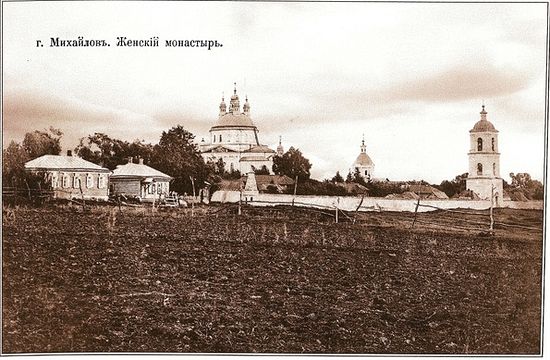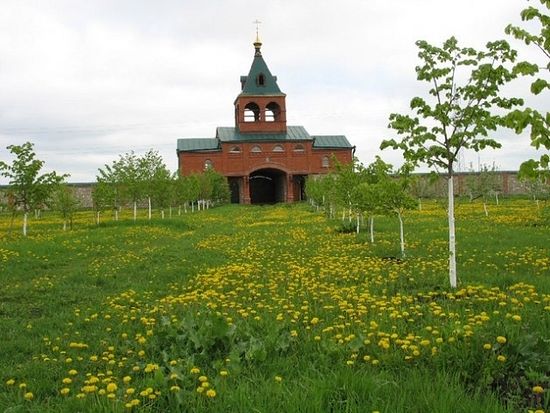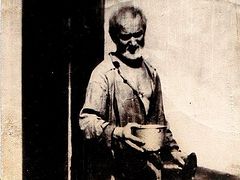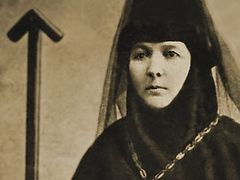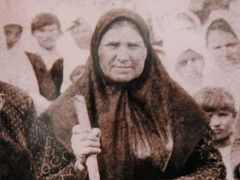2019 marks the 200th anniversary of Holy Protection-Mikhailova Convent in Chernaya Gora (Ryazan Diocese) and the 20th anniversary of its revival. Originally (according to written sources from the sixteenth century), the monastery stood about nine miles from Pereyaslavl Ryazansky (modern Ryazan) and was called the Ryazan Hermitage of the Protection of the Mother of God. After the secularization of the monastic lands,[1] it fell into decline by the beginning of the nineteenth century, and in 1819 it was transferred to Chernaya Gora, near Mikhailova. 100 years later, in 1919, the monastery was closed, and monastic life revived only in the autumn of 1999.However, the monastic tradition was not lost: The lives of the zealots of piety who labored in this holy place and the prayerful memory of them were preserved and received with care by a new generation of monastics. One such example is the story of Blessed Evdokia (Plyakhanova), presented here.
Already more than 100 years have passed since the repose of Eldress Evdokia—Matushka fell asleep in the Lord on November 6, 1890. After the revolution, the place where she labored was turned into an empty lot; the graves of the abbesses and sisters of the monastery were destroyed by the locals and their remains were mixed with the dirt… But the example of the life and podvig of the eldress and her instructions now strengthen the inhabitants of the revived Holy Protection Monastery in their faith.
Eldress Evdokia entered the Protection Monastery in MIkhailova at twenty years of age and lived in her chosen monastery for seven years, showing from the first days an example of obedience, amazing even for the experienced inhabitants. After this period, Evdokia entered upon the path of foolishness for the sake of love for God, striving for the perfection of life in Christ. Her entire life was spent in unselfish service to others, unmurmuring endurance of sorrows and severe illness, and was a true Christian podvig.
The future ascetic was born in Tula in 1830, in the middle class Plyakhanov family. It is known that her father served in an arms factory and also had two sons. From her early years, the girl loved solitude and prayer. Despite her blossoming beauty and the fact that she had no shortage of admirers and suitors, Evdokia grew stronger and stronger in her desire to devote her life to God.
When she turned twenty and had to make a decision about her future path, Evdokia revealed her heart to her parents and asked their blessing for monasticism. Initially she wanted to enter the Tula Convent; however, seeking the will of God in everything, she asked the advice of the of a fool-for-Christ revered in Tula who pointed to the Mikhailova Convent as the place of her asceticism, where she was later received by Abbess Elpidophora (Afanasova).
She served as the cell attendant for one of the strictest nuns of the monastery, and in her free time from bearing obediences, she would help the other elderly sisters, chopping wood, washing clothes, and carrying water from the well.
Seven years later, to the surprise of many, she changed. Evdokia—undoubtedly with a blessing—took on one of the most difficult podvigs—foolishness for Christ. At first, they considered her crazy and treated her with contempt and persecution. But over time, everyone recognized the essence of her podvig by the considerable spiritual fruits she developed.
Evdokia diligently attended the services, afterwards trying to return to her cell as soon as possible, where she devoted all her time to prayer. As before, she tried with all her might to serve others—she washed the sisters’ clothes, sewed their shoes, and sometimes knit caps out of marsh grass.
In the summer the blessed one would wear warm clothes, and in the winter she went about barefoot. She kept a very strict fast. If she noticed any reverence from the sisters of the monastery, then she became sharp, trying everything to push them away.
Sometimes Evdokia would visit her relatives in Tula and go on pilgrimage to Kiev. She loved to wander, finding the opportunity to be in complete prayerful solitude.
At first, she lived in the cold loft of the cell of one of the nuns of the monastery. She spent seventeen years there and then had to move to the cellar, located under another cell, where she lived for five years; and when the nun in the cell required the room, she relocated to the barn.
With the blessing of the abbess, the eldress finally had to find her own stone cell, but even there she tried to make severe conditions for life: She didn’t heat the stove and she would leave the doors half-open in the most severe frost. She had chickens and pigeons where she lived, using all of this to try to fence herself off from people. Her cell had only icons, a small table, a bench, some shabby clothes, and a few dishes, and there was also a coffin standing inside it.
The abbess protected her, and Evdokia rendered full obedience to Matushka and revered her. But when the abbess would give her some clothes, the blessed one would try under one pretext or another to refuse the gift or to give it to those in need. For herself, she would accept only a few grains.
For those who turned to her for spiritual advice, above all she taught them mercy to neighbors, to give alms, to be unselfish, and to rely on the will of God in everything.
Seeing the eldress’ spiritual prosperity, not only the sisters of the monastery started turning to her but also visiting monastics and laity. By her advice, the eldress strengthened people on the path of salvation in bearing sorrows and temptations, and called them to repentance and the correction of their lives.
Enduring not only privations without murmuring, but often insults and reproaches from people, she tried to show even greater love to those abusing her.
With age, Evdokia’s legs began to seriously hurt from the cold and long standing in prayer and they began to turn gangrene. She endured the severe, mortal illness with the same humility, betraying nothing of her sufferings. And until her final minute, she had compassion on the suffering.
Having communed of the Holy Mysteries of Christ and having bid farewell to the sisters, the blessed Eldress Evdokia quietly reposed in the Lord on November 6, 1890, in her sixty-fist year of life, having spent forty years in the monastery, thirty-three of which she bore one of the most severe Christian podvigs—foolishness for Christ’s sake. She was buried not far from the altar of the Holy Protection Church.
Until the closing of the monastery, they would serve panikhidas on the site of the eldress’ grave, and the sisters would go to her grave with their sorrows and perplexities as to their spiritual mother. The eldress’ life and counsels, following Patristic wisdom and the precepts of the teachers of monasticism in everything, were transmitted orally in the monastery: “Do not seek and do not expect love from people! Seek earnestly and demand from yourself love and compassion for others.”[2]

